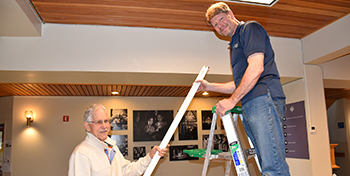To conserve energy, church replaces incandescent lights with LED
 |
| Bob Palrud helps Gib Dominguez replace lighting in St. Mark’s Lutheran Church’s entry. |
To conserve energy, St. Mark’s Lutheran Church removed its old incandescent lighting and installed new LED lighting. By doing that in late 2016, it benefited from a rebate program with Avista Utilities.
Sexton Gib Dominguez climbed a tall ladder in the sanctuary and replaced 122 light bulbs through the entrance hall, hallways and sanctuary, and 20 bulbs lighting the cross, pulpit and choir area in December and January, plus others around the building.
The lights provide as much illumination at the same quality as the previous light bulbs, plus they are dimmable and last ten times longer, meaning fewer trips up the ladder for Gib.
Avista is offering a similar program for 2017, said Rachelle Humphrey of Avista.
At the start of this winter’s extreme cold, St. Mark’s member Bob Palrud, who had developed a program to test for air leakage in buildings and did more than 3,000 energy audits in homes in the 1970s and 1980s, noticed a one-eighth-inch gap above the hand-carved entry doors at St. Marks.
That was a simple fix. Gib replaced the weather stripping.
Bob, who moved to Spokane four years ago with his wife to be near her sons in the Silver Valley, earned a bachelor’s degree in 1970 at St. Olaf College to be a physicist and earned another degree in 1973 in forensic science. He applied skills from that training to look at details in order to understand how heat, light and energy can be conserved.
“Small stuff adds up to make a difference,” he said, offering ideas that other churches might use to increase energy efficiency and save funds.
Bob, who grew up Lutheran, lived many years in Minnesota, where he applied those skills to energy conservation and opened an energy program in several suburbs of Minneapolis and other communities of Minnesota.
For several years, he worked with a local nonprofit and the local utility, Northern States Power, which is now part of Avista. They funded him doing energy audits, beginning in Richfield, Minn., and moving on to other Twin Cities suburbs.
In the 1980s, he had taught chemistry and physics at a Lansing, Mich., community college. He also taught about energy audits and use of caulk, weather stripping and compact fluorescent lights to save energy.
“We can help change the world by screwing in an energy efficient light bulb,” he said.
Bob married in 2000 and moved to Wyoming, where his wife had taught school for 32 years. He was there three years until she retired. Now semi-retired, he continues to work painting houses inside and outside.
Concerned about climate change, he has sought to be proactive every day, ranging from what car he drives to making his house energy efficient.
The light-bulb replacement project emerged when he was sitting in choir and noticed the lights in the sanctuary. He realized there might be savings for the church if they changed their lighting.
He learned about the Avista rebate program and sent in information on the number of Energy Star rated bulbs and number of fixtures. Certain lights were eligible and the program awarded the highest impact changes with the best rebates, Bob said.
It was an energy saving solution that was easy to do.
Working with advice from a local lighting supplier on details such as dimmer compatibility, St. Mark’s changed 170 bulbs and expects to reduce peak lighting by about 7,000 watts, Bob said.
“While not all of the changes were rebate-eligible, the substantial Avista rebate made it easier to ignore the technical payback periods and cut waste immediately,” he said.
Bob believes energy conservation is important and can prevent wars over resources.
“There are many ways to move the powers of civilization around, and we have a moral obligation to pay attention and do what we can,” Bob said. “There are different ways to address the world’s problems and energy conservation is one. We have a moral obligation to find positive ways to affect the world.
“So screwing in an energy efficient light bulb can become a moral act. Wasting energy can be a sin, paired with obvious consequences of climate change that affects the world,” he said.
“I hope people in other Spokane congregations will see the simplicity and beauty of changing their light bulbs,” Bob said.
“We are ignorant of how most of the world functions and struggles with or without energy,” he said.
The application for Avista’s commercial lighting exchange program for 2017, which is available online at avista.com, spells out eligibility and incentives Rachelle at Avista explained.
“There are many benefits to changing out old, inefficient lights with more efficient lights,” she said. “Those benefits include enhanced lighting quality, energy savings, energy cost savings and reduced maintenance costs.”
The program includes incentives for lighting retrofits, installing occupancy sensors and lighting upgrades. Some common lighting upgrades include changing from fluorescent and incandescent to LED—light-emitting diode—lights.
For information, call 747-6677 or 495-2099, or visit Avista Utilities Rebates page.
Copyright © April 2017 - The Fig Tree






